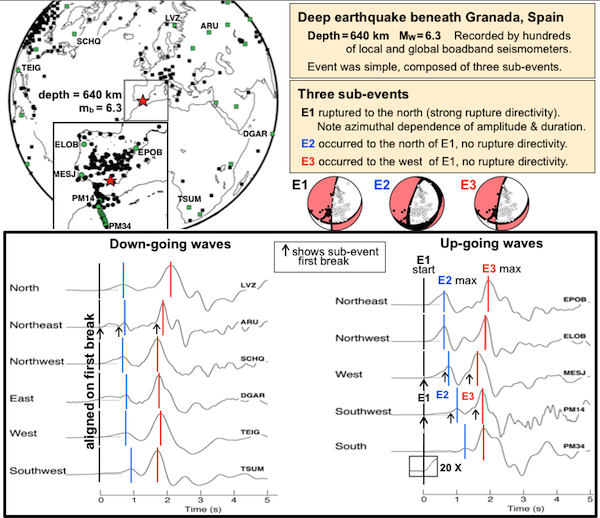2012 IRIS Workshop
Contrasting rupture processes for sub-events within a well-recorded deep earthquake
Max Bezada: University of Oregon, Gene Humphreys: University of Oregon
Upper left: Seismometers used in our study. Center right: Focal mechanisms for the three sub-events. Bottom: Velocity seismograms. Black line is E1 first break. Blue and red lines are E2 and E3 maxima. Trace polarities chosen so that first breaks are up. Note: (1) sub-event relative timing (used to locate earthquakes relative to each other); (2) E1 amplitude and duration depends on back azimuth in a way that indicates E1 ruptured to the north; and (3) E3 show no dispersion, indicating that rupture area was small.

Full-resolution graphics file in original format: 0136.tiff
The 2010 Mw = 6.3 deep-focus earthquake beneath southern Spain consisted of three resolvable sub-events occurring within 3 s duration, all within 5 km of each other. Directivity analysis indicates that the first sub-event ruptured unilaterally for ~9 km, yielding a stress drop of ~3 MPa (typical of crustal earthquakes). In contrast, the following sub-events show no clear directivity. The third, best resolved, sub-event had a hypocenter ~2 km from the first and a focal mechanism indistinguishable from it. The maximum rupture dimension of this sub-event is ~5.5 km, yielding a stress drop of 60-1000 MPa. Given the proximity and indistinguishable focal mechanisms of the first and third sub-events, we assume they occurred under similar ambient stress. But 䊫 60 MPa is much greater than the stress drop of the first sub-event, implying that its weakening was transient, i.e., the first sub-event ruptured as a slip pulse. The large stress drops of the second and third sub-events suggest a crack-like rupture without fault healing and with nearly total stress drop. Fault-zone melting and meta-stable olivine are viable mechanisms for these ruptures. In contrast, the rupture characteristics of the first sub-event seem incompatible with all mechanisms currently under consideration for deep-focus earthquakes.
Acknoweldgements: Spanish and Moroccan collaborators. NSF Continental Dynamics Program for funding the PICASSO project. good luck, for getting a deep earthquake shortly after deployment of seismometers.
Keywords: rupture_mechanism, deep_earthquake
